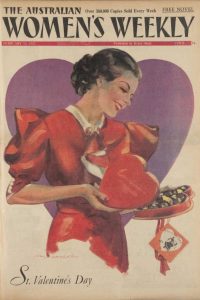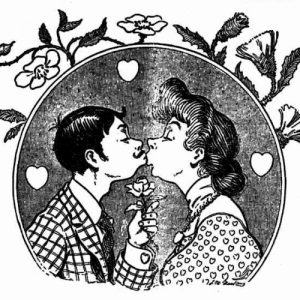
The earliest mention of Valentine’s Day in an Australian context was in 1825.[2]
The sending and receiving of Valentine’s Day cards was a popular practise. Cards were usually sent anonymously, or with the sender’s initials. It was part of the fun of the occasion for the receivers of the cards to wonder who it was who had a romantic interest in them. As one newspaper noted, “Secrecy was their very essence and recipients got much innocent pleasure from conjecturing upon the identity of the senders.”[3]
However, the popularity of Valentine’s Day and the sending of cards waned in the late 19th Century. Australian newspapers commented on the decline, saying that the day had “fallen out of favor”, was “almost forgotten”, and was “dying out”. The Shoalhaven Telegraph, in 1897, predicted the occasion’s demise, saying “there can be no doubt that the custom observed on the 14th February will soon be numbered among the interesting memories of the past.”[4]
The decline of the occasion, and the downturn in the sending of Valentine’s Day cards, may have been due to the advent of the use of the sentimental cards being overshadowed by the practise of sending comical, humorous, and ribald cards, so that “friends might be mercilessly ridiculed”. Even worse, sometimes cards were sent with nasty or spiteful intent (which was very easy to do, when the cards were being sent anonymously).[5]
As a comment on this practise, The Ballarat Star, in 1880, said:
“that quaint old fashion of choosing a lover for a day, curiously mingled as it is in our minds with fresh mornings in the country and antique figures in the romantic garb of the past, has long since passed away, and with it all the grace and simplicity that surrounded it, and in its place we have the modern element of coarse ribaldry and coarser caricature, a bitter mockery of a simple kindly custom.”[6]
A letter-writer to the The Saturday Journal (Adelaide), in 1923, blamed the demise of the Valentine’s Day cards on the non-romantic cards, as well as the popularity of picture postcards:
“The sending of these missives was a quaint custom, and survived for many years. Originally it was introduced as a purely complimentary exchange between sentimental lovers, or as a tribute to a much-admired friend of the opposite sex, but several factors served to sound the deathknell of the custom. The “ugly” valentine made its undesirable appearance, and was as often as not of a highly objectionable character, with grotesque caricatures and offensive verses. These were frequently sent, not in harmless jest, but with the intention of wounding the susceptibilities of the receiver. Often the verses were supplemented with objectionable sentences added by the sender. The recipient making a perhaps erroneous guess at the sender, would dispatch something equally objectionable, and thus was stimulated that detestable bane — the anonymous letter. Some shopkeepers noting this, declined eventually to do any trade in the ugly variety, and patrons were sometimes annoyed in consequence. All this served to make the valentine less popular; then came the picture postcard craze, which finally displaced the valentine, and even to a large extent the Christmas card, and now in its own turn has almost run its course.”[7]
With the rise of the nasty and spiteful cards, the The Register (Adelaide, SA), in 1903, opined that it was a good thing that Valentine’s Day was on its way out.
“The Ugly Valentine, however, was in every way an offence. It consisted of a caricature roughly coloured, with a few lines of doggerel verse; and by its means any one could suggest to persons he disliked that they were asses or snakes in the grass — each of these forms had a large sale — or merely misers, drunkards, or wife-beaters. The whole intention was spiteful, and intense pain was often given by anonymous missives of this nature. Unhappy indeed, was the case of a young lady who expected valentines sentimental or merely complimentary, and received instead a flaring accusation of husband-hunting, tale-telling, or the undue use of powder or paint. The community is well rid of this side of the valentine custom, and the other is no great loss.”[8]
A writer for The Mt. Barker & Denmark Record (Albany, WA) explained how a measure of notoriety had attached itself to the Valentine’s Day tradition of sending anonymous cards:
“There are always some persons ready to vent their spite and pay off private grudges under the cloak of anonymity. So there appeared in stationers’ windows scurrilous lampoons designed to give offence, mortify and wound. A typical example was an excessively long, narrow sheet (the more unusual the size and shape of the mysterious postal package the better) depicting a fearsome looking serpent winding a tortuous way through a verdant meadow. At the head of the undulating body was a human countenance from the mouth of which issued a bubble announcing “The Snake in the Grass.” On the morning of Valentine Day the victims of such abusive and cruel libels felt the more harrowed when they saw others round the breakfast table smiling over their winged Cupids and sentimental verses. Valentines caused nearly as many heart-burnings as burning hearts.”[9]
 Fortunately, Valentine’s Day underwent a revival in Britain and America, which may have influenced its comeback in Australia in the mid to late 20th Century.[10]
Fortunately, Valentine’s Day underwent a revival in Britain and America, which may have influenced its comeback in Australia in the mid to late 20th Century.[10]
Valentine’s Day is a special time for celebrating romance with one’s lover, or taking the time to express one’s romantic feelings. On this occasion, it is traditional for lovers to exchange gifts. Cards, chocolates, and flowers are the usual tokens of affection (a card with some poetry about love might be appreciated); or lovers may go on a date, or take a holiday together. It is a nice gesture for people to send cards to those they are fond of, or with whom they have fallen in love with.
Whichever way you do it, Valentine’s Day is a great opportunity to show your appreciation of your loved one.
See also: Valentine’s Day
A list of articles about Valentine’s Day.
References:
[1] “History of Valentine’s Day”, History
Taysha Murtaugh and Rebekah Lowin, “The true history of Valentine’s Day might surprise you — here’s what to know”, Country Living, 28 January 2018 (updated 31 January 2023)
“Valentine’s Day: social custom”, Encyclopaedia Britannica
“Valentine’s Day”, Wikipedia
“Saint Valentine”, Wikipedia
[2] “A Valentine”, Hobart Town Gazette, and Van Diemen’s Land Advertiser (Hobart Town, Tas.), 18 February 1825, p. 3
[3] J.B.C., “St. Valentine’s Day: A fading festival”, The Mt. Barker & Denmark Record (Albany, WA), 11 February 1946, p. 3
[4] “St. Valentine’s Day: No valentine trade: Valentine chit chat”, The Herald (Melbourne, Vic.), 14 February 1894, p. 3 (“dying out”)
“Valentine’s day”, Morwell Advertiser (Morwell, Vic.), 21 February 1896, p. 3 (“fallen out of favor”; “almost forgotten”)
“Valentine Day: Vanishing Valentines”, The Shoalhaven Telegraph (Nowra, NSW), 10 February 1897, p. 4 (“memories of the past”)
“St. Valentine’s Day”, The Evening Journal (Adelaide, SA), 15 February 1900, p. 2 (“almost if not completely died out”)
“Vanished St. Valentine”, Newcastle Morning Herald and Miners’ Advocate (Newcastle, NSW), 22 February 1902, p. 3 (“is rapidly becoming a saint’s day of the past”)
“Her valentine”, The Daily Telegraph (Sydney, NSW), 10 February 1915, p. 17 (Third Edition) (“fallen into disuse”)
[5] “St. Valentine’s Day”, The Ballarat Star (Ballarat, Vic.), 16 February 1880, p. 3 (“spiteful”)
“Valentine’s day”, Morwell Advertiser (Morwell, Vic.), 21 February 1896, p. 3 (“mercilessly ridiculed”)
[6] “St. Valentine’s Day”, The Ballarat Star (Ballarat, Vic.), 16 February 1880, p. 3
[7] “St. Valentine’s Day”, The Saturday Journal (Adelaide, SA), 17 February 1923, p. 12 (Night Edition)
[8] “The vanished Valentine”, The Register (Adelaide, SA), 14 February 1903, p. 4
[9] J.B.C., “St. Valentine’s Day: A fading festival”, The Mt. Barker & Denmark Record (Albany, WA), 11 February 1946, p. 3
[10] “St. Valentine’s Day. Revival foreshadowed”, The Bowen Independent (Bowen, Qld.), 6 January 1937, p. 4
“An Editorial: St. Valentines Day”, The Australian Women’s Weekly (Sydney, NSW), 13 February 1937, p. 12
Leave a Reply